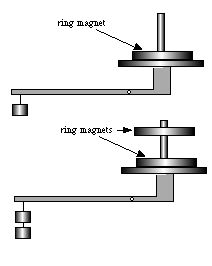Demos: 6A-02 Weighing a Suspended Magnet

Directions: Place one ring magnet on the dowel rod as in the first figure and adjust the balance for equilibrium (picture here is symbolic). Then pick up another ring magnet (having determined ahead of time the polarities of the magnets) and place it over the dowel rod so that like poles face each other. Readjust the balance and note the difference in the two readings. Then independently weigh the ring magnet and show that the two numbers are the same.
Suggestions for Presentation: First place a ring magnet on the pan of the balance (without the dowel rod) and note its mass. Then ask how the reading might change if another magnet is placed on the pan. Would it matter if the poles attracted or repelled? Then set up the apparatus and balance it with the dowel rod and one ring magnet, as in the first diagram. Support the weight end of the balance in some way so that it can’t move. Place the second magnet over the dowel rod as specified above and show that the magnet “floats” above the other one. Have the class predict what, if anything, will change when you remove your hand. You might also suggest that if the poles were reversed on one magnet and they attracted each other, there would be an additional force that would make the weight even greater! Then try it.
Applications: Similar effects occur when a fish is floating in a tank of water. Does it increase the weight?
Last Updated: Nov 30, 2023 11:25 AM